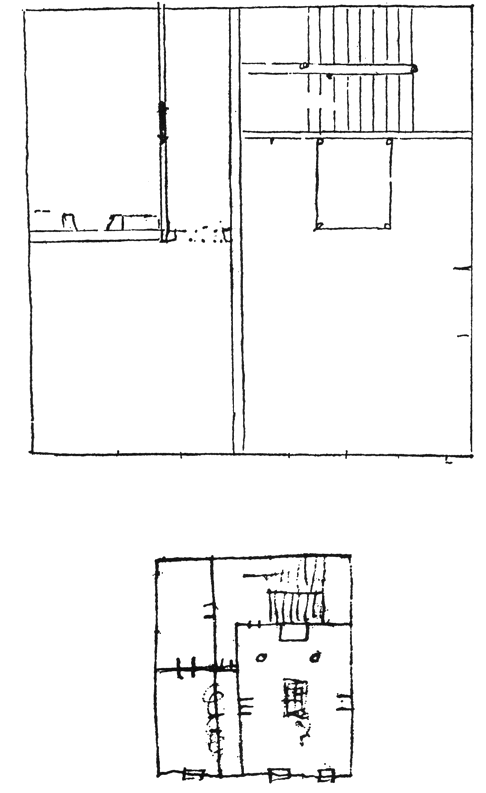Deborah Franklin to Benjamin Franklin, [6–13 October? 1765]
From Deborah Franklin
AL (fragment): American Philosophical Society
This document begins close to the upper margin of a leaf, without date or salutation but with “(5),” possibly a part of the original writing, at the top. The paper is in Deborah Franklin’s hand, but there is no signature. The writing occupies the whole of one rather large page, with the paragraph beginning “Salley is still att Burlinton” written sideways in the left margin. The remainder is written sideways on a second and otherwise blank leaf. Marginal tears on both leaves and stains on the second leaf have obliterated some words.
The manuscript is almost wholly without punctuation, and in several instances Deborah’s intended breaks between sentences are not entirely certain. In order to avoid any possibility of misleading the reader or unwittingly altering the sense, the editors have departed from usual practice and, wherever we believe the sense requires such a break, have surrounded with brackets the supplied periods and the following initial capitals that have been substituted for lower-case letters. If the brackets surround only a period, it is to be understood that the next word begins with a capital in the manuscript. Lesser punctuation than the period is left for the reader to supply.
[October 6–13? 1765]5
This is an anser to your qustons[.]
When you wente from home Billey desired to take sume more of your Books then what you laid ought so I got him a trunke to take them up in and as the shelveses looks prettey emtey I took down the reste and dusted them and had the shelves taken down and put up in the South Garrotes in the new house and Mis Elmer6 and my selef put them up[.] I took all the dead letters and papers that was in the Garrot and put them into boxes barrels and bages as I did not know in what maner you wold have shelves in your room[. N]ow this I did for several resens one as it did imploy my mind and keepe me verey busey and as the wather was prittey good and I shold make room if Mrs. Franklin7 shold Come to town to stay aney time I was readey to reseve her[. N]ow for the room we Cale yours8 thair is in it your Deske the armonekey maid like a Deske a large Cheste with all the writeings that was in your room down stairs the boxes of glases for musick and for the Elicktresatecy and all your close and the pickters as I donte drive nailes leste it shold not be write[.]

Salley is still att Burlinton[.] I wrote her that Capt. Friend wold saile this week[.] I hope shee writes to you[.] Capt. orrey [Ourry8] took with him her white Sattin to have maid fitt to wair agin[.] I donte know wather shee wrote a bought it or know have you ever seen Capt. orrey sens he a rived[. M]y Compleymentes to our Good mrs. and miss Stephenson and all friends as thow menshoned[.] I have Counted the paines in the dores thair is 8 in each dore be sides the spaces[?] att tipe the largest Sise[.] I will get mr. Rhodes to take mashuer of the fierplases and the pier for a Glase[. A]ll the Chimneys that I have yoused is verey good[.]9 I have baked in the oven and it is good[. T]he same man lives in house that did when I bought it but I donte know his name[.1 H]e paid 26 pounds a year but now the Lott is taken of[f]2 but he never spook to [me as] he is a Duchman I have not spook to him only to make a watter tube [tub] for the arrey [area.]3 The pente houses4 is not dun nor the stepes as the loot is not setteld[.] I fair you have not reseved all my letters[. I told you?] mr. Rhodes thought it beste not to dig a volte but I shall see him this evening if I Can but I donte go ought aney whair if I Can helpe it[.]
I have seen mr. Rhodes and [a tear and four illegible words] it the Carpenter Come on freyday and put up some Cornishes [illegible] Come to put up the Stepes at the north dore as mr. Rhodes thinks it may be [illegible] have voltes [vaults] att [illegible] place fenced of[f] for [illegible] he and mr. Smith think[?] it will all ways be a harbor for Rattes[?] and such Creepin things that is a [illegible] and I have Consented to have it don [illegible] I did write to you in the Spring and since for your orderes[?] I hope the Smith will put railes on the house to morrow[.] I due take all the Caire of the fiers in my power and some sort beside [illegible] for the men keep fier in two roomes while they worked and I did littel else but tend them least any acksidente shold hapen[.]
5. The period within which DF wrote this piece depends chiefly on internal evidence. Sally, she wrote near the end, was still at Burlington, and Captain Friend was to sail “this week.” Sally returned on Sunday evening October 13 (below, p. 317), so DF must have been writing no later than that day. David Hall sent BF a letter dated October 14 by Friend (below, p. 321), so the captain’s earliest possible day of sailing must have been Monday, October 14. If we allow a little latitude for DF’s use of the words “this week,” she probably was writing her husband no earlier than Sunday, October 6. This paper consists of answers to questions about the new house BF had asked in a letter believed to have been written in August and received by DF from Captain Caton on Sept. 21, 1765 (above, p. 293 n). On October 9, DF wrote BF that she had answered all his questions but the letter had disappeared and she would have to rewrite it (below, p. 303). The present document is possibly part of her original reply, recovered after the 9th; if however, it is a second effort, it would appear to have been written between the 9th and the 13th.
6. Not identified. After reaching England, Capt. Lewis Ourry (mentioned below), wrote DF, Sept. 26, 1765, thanking her for her civilities and sending his compliments to “Miss Sally” and “Miss Elmore.” APS. The latter was probably the friend who helped DF in this business of moving.
7. WF’s wife, Elizabeth.
8. For most of the rooms described here see the contemporary rough sketches reproduced on the facing page. The “room we Cale yours” appears to have been the large room with a four-poster bed in the southeastern part of the second floor.
9. That is, up two flights of stairs, on what Americans would call the third floor. No sketch of this story has been found.
1. “Nanney” or “Nancy” was Ann Hardy, a former servant of Mrs. Stevenson who had gone to America in 1763 and lived in the Franklin home for a few years before returning to England; above, X, 334 n. Her room appears also to have been on the third floor.
2. The unpublished “Historic Structures Report, Part I on Franklin’s House,” prepared by the staff of Independence National Historical Park, December 1961, chap. II, sect. I, p. 8, identifies this room as “the large east room on the third floor,” that is, directly above the room called BF’s. As DF describes it, this room seems somewhat more elegantly furnished than might be expected of one at the top of the house and adjacent to sleeping quarters, until it is understood that this was what DF called in a later letter “the musick room,” and was probably by intention set away from possibly disturbing bustle and noise elsewhere in the house.
3. The southwestern room on the second floor.
4. DF’s maid.
5. The small bedroom on the northwest corner of the second floor.
6. The large room in the southeastern part of the first floor. This was the dining room. Gunning Bedford’s insurance survey of Aug. 5, 1766, describes it as: “East Room. below wainskuted with frett Cornish all Round, four pedements with frett Bedmolds A Rich Chimney Peice, fluted Cullums and half pilasters with intabliture.” Philadelphia Contributionship for the Insurance of Houses from Loss by Fire, Survey No. 1148.
7. A rich and heavy corded silk stuff.
8. In the southwest corner of the first floor.
9. For BF’s order of two prints of the Earl of Bute engraved by William Wynne Ryland from Allen Ramsay’s full-length portrait, see above, X, 395; XI, 334.
1. The room at the northwest corner of the first floor.
2. On April 6, 1766, after the repeal of the Stamp Act removed any objections to sending goods from Great Britain to the colonies, BF sent DF, among other purchases, “A large true Turky Carpet cost 10 Guineas, for the Dining Parlour.” APS.
3. For this social occasion, see above, p. 102.
4. Hannah Walker (A.5.2.3.3.1), a lacemaker of Westbury, Northamptonshire, who had written BF a letter of welcome in December 1764 upon his return to England; above, XI, 524–5. In April 1766 BF sent DF lace for two caps and most of the other things she suggested here.
5. A portrait of BF’s eldest full brother, John Franklin (C.8). It has since disappeared. If it was later given to WF, as has been surmised, it may have been destroyed with others of WF’s effects in a fire at a British army warehouse. Charles C. Sellers, Benjamin Franklin in Portraiture (New Haven and London, 1962), pp. 32–6, 44.
6. There is no record of BF’s acquisition of these pictures; he may have brought them home from England in 1762, and as an officeholder under the Crown he would have been proud to display them in his new house.
7. In his letter of inquiry BF had asked: “Is the Passage out to the Top of the House fixed with Iron Rails from Chimney to Chimney?”
8. Lewis Ourry (above, VII, 62–3 n), a British Army officer who had served under Bouquet and had become friendly with the Franklin family, had returned to England aboard the Prince George, Capt. J. Robinson, which cleared Philadelphia for London in the middle of June 1765. Pa. Gaz., June 20, 1765. He wrote DF, Sept. 26, 1765, that he had tried two or three times to have BF and Mrs. Stevenson at his house for “a bit of Mutton,” but had as yet been unsuccessful in arranging a date. APS.
9. Smoky chimneys were a long-standing concern of BF, and on July 13, 1765, he had asked DF particularly how the kitchen chimneys in the new house worked; above, p. 211.
1. This was the tenant house at the Market St. end of the lot recently acquired from Anthony Syddon. BF had asked about the tenant and the rent paid.
2. Since this tenant would no longer have the use of the rear portion of the former Syddon lot, his rent would presumably be somewhat reduced.
3. In his (undated) August letter BF had stressed that DF “should never be without Tubs sufficient in the Area to catch the Rain Water,” to prevent an overflow that might cause the foundation to settle.
4. Extensions of the front and back roofs at the eaves along the north and south walls. The Gunning Bedford insurance survey indicates that they were supported by trusses at each end.

![University of Virginia Press [link will open in a new window] University of Virginia Press](/lib/media/rotunda-white-on-blue.png)
